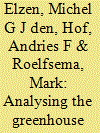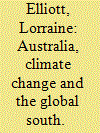|
|
|
Sort Order |
|
|
|
Items / Page
|
|
|
|
|
|
|
| Srl | Item |
| 1 |
ID:
121321


|
|
|
|
|
| Publication |
2013.
|
| Summary/Abstract |
As part of the Cancún Agreements, 45 non-Annex I countries have pledged mitigation action plans, of which 16 countries, including the seven major emitting countries, have submitted quantified mitigation actions. Many countries published their business-as-usual (BAU) emissions to which their pledges are connected. This study analyses the expected emission levels from the pledged, quantified actions, and whether these are consistent with achieving the 2 °C target. One of the main findings is that new BAU emission projections have led to about 2.5 GtCO2eq higher emission levels expected from pledges by non-Annex I countries. The emissions for non-Annex I countries as a group would be between 9% and 12% below our 2020 BAU emission projections, for, respectively, the unconditional and conditional pledges. This result might be conservative as we assume countries without quantified pledges follow BAU. This implies that for a medium chance of achieving 2 °C, Annex I countries would need to reduce its emissions by about 50% below 1990 levels by 2020. If Annex I countries as a whole would reduce emissions by 13% to 18% below 1990 levels, as expected from the pledges, the reduction of non-Annex I countries should be 22% to 34% below BAU levels for a medium chance of achieving 2 °C.
|
|
|
|
|
|
|
|
|
|
|
|
|
|
|
|
| 2 |
ID:
108149


|
|
|
|
|
| Publication |
2011.
|
| Summary/Abstract |
Australia's climate change relationship with developing countries is framed by the 1992 United Nations Framework Convention on Climate Change and the 1997 Kyoto Protocol. Under those agreements, Australia has committed to take a lead in cutting greenhouse gas emissions and to provide technological and financial support to developing countries. In practice, Australian governments of both political hues have adopted a somewhat ambiguous and ambivalent attitude to developing countries within climate change politics and their fulfilment of those commitments has been uneven. This is particularly so if the concept of the 'Global South' is expanded from developing countries to include those people who are vulnerable to the environmental, social and economic impacts of climate change.
|
|
|
|
|
|
|
|
|
|
|
|
|
|
|
|
| 3 |
ID:
098475


|
|
|
| 4 |
ID:
099252


|
|
|
|
|
| Publication |
2010.
|
| Summary/Abstract |
This paper analyses the environmental and financial consequences of various strategies of dealing with surplus emission allowances in the aftermath of the Copenhagen Accord. This topic remains relevant, in particular, with respect to the Russian negotiation position, as this country is the largest holder of surplus emissions. It is concluded that not addressing the surplus problem is not a feasible negotiation option, as the sheer size of the surpluses would jeopardise the environmental integrity of any future agreement. Cancelling surpluses against Russia's will, though viable, is not desirable, as it might well lead to this country opting out of this climate treaty. Three options for compromise have been selected and analysed here: (1) stricter targets for Annex I countries; (2) strategic reserve for Russia; (3) institutionalising optimal banking. It is concluded that, whereas option 1 is environmentally the best, in the present political context it is probably less feasible. The other two options, although environmentally suboptimal, seem politically more favourable. Our analysis suggests that maximal revenues for surplus-holding countries arise by releasing only a limited amount of surplus credits to the market. The institutionalisation of this effect could be a key lever to a politically feasible agreement on surplus emissions.
|
|
|
|
|
|
|
|
|
|
|
|
|
|
|
|
| 5 |
ID:
105789


|
|
|
|
|
| Publication |
2011.
|
| Summary/Abstract |
A multi-region, multi-sector dynamic computable general equilibrium model is applied to explore the economic and welfare effects of the pledges submitted by developed countries (Annex I countries) and major developing (non-Annex I) countries for 2020 under the Copenhagen Accord. In addition to analyzing scenarios reflecting the upper and lower bounds of the Copenhagen Pledges, one additional policy scenario where Annex I countries as a group reduce CO2-emissions by 30% in 2020 compared to 1990 levels, and where major non-Annex I countries reduce CO2 emissions 15% below baseline, is also analyzed. Economic effects are measured as changes in GDP compared to baseline and welfare effects are measured via the equivalent variation. Assuming that countries with emission targets may trade certificates, average reductions in GDP for countries with targets range between 0.1% and 0.7% in 2020 for the policy scenarios. While the GDP losses are larger for major non-Annex I countries with emission targets compared to Annex I countries, this is not the case for the changes in welfare. With the exception of Mexico, the welfare losses for the major non-Annex I regions, as a percentage of projected GDP in 2020, are lower than for the large Annex I countries.
|
|
|
|
|
|
|
|
|
|
|
|
|
|
|
|
| 6 |
ID:
110428


|
|
|
|
|
| Publication |
2011.
|
| Summary/Abstract |
This study provides a conceptual framework for exploring the bargaining space within international climate negotiations based on important economic, political and environmental considerations. Based on it, we analyse combinations of the proposed emission reduction ranges for Annex I countries as a group (25-40% below 1990 levels) and non-Annex I as a group (15-30% below baseline) by 2020 to limit global warming to 2 °C. We use results of the FAIR model with costs estimates based on two energy system models. We conclude that the range of targets that comply with a set of criteria for economic, political and environmental considerations is smaller than that by environmental considerations alone. More specifically, we find that according to our criteria, a 30% Annex I reduction target below 1990 levels, combined with a 20% non-Annex I reduction target below baseline emission levels (i.e. 20 to 30% above 2005 levels), is the only combination of targets fulfilling all our criteria for both energy system models. Otherwise, reaching the 2 °C target becomes less likely, technically infeasible, or non-Annex I abatement costs are likely to exceed those of Annex I, a result, which we consider less plausible from a political viewpoint in our conceptual framework.
|
|
|
|
|
|
|
|
|
|
|
|
|
|
|
|
| 7 |
ID:
112316


|
|
|
|
|
| Publication |
2012.
|
| Summary/Abstract |
As the Copenhagen Conference of Parties (COP) failed to negotiate a binding Post-Kyoto agreement, an alternative is proposed based on the Copenhagen Accord (CA). The CA, as endorsed by COP16 in Cancun, aims to combat global warming with differentiated reduction targets of greenhouse gas emissions and by mobilizing resources supporting adaptation and carbon-free technology in developing countries (DCs). Using a special version of MERGE, we study the global implications of the CA postulating extensions of the Accord in the direction of Technology Transfer Protocols (TTPs). We assess scenarios needed to reach sustainable climate targets under such Protocols. It is shown that without binding commitments for DCs, the warming target of 2 °C will be exceeded with a probability above 50%, even if Annex B countries eliminate their emissions. However, moderate commitments of DCs (when they reach sufficient economic development), make the 2 °C scenario feasible. TTPs combined with binding emission reduction targets thus provide a mechanism to reduce climate change damages, and may generate significant secondary benefits. For example, the reduced tax-subsidy scenario (RTS20) has 77% to 40% chances to remain below 2 °C of warming and an undiscounted cumulative gross domestic product (GDP) cost of 0.75% relative to baseline (not accounting for the benefits of avoided damages).
|
|
|
|
|
|
|
|
|
|
|
|
|
|
|
|
|
|
|
|
|